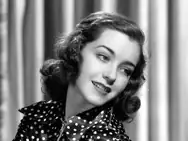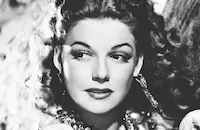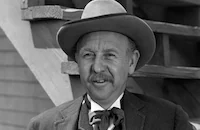College Holiday

Brief Synopsis
Cast & Crew
Frank Tuttle
Jack Benny
George Burns
Gracie Allen
Mary Boland
Martha Raye
Film Details
Technical Specs

Synopsis
Dick Winters falls in love with Sylvia Smith at a college dance, but before he can learn her complete identity, she is called away to California where her father is ill. Sylvia discovers that her father's beachside hotel, Casa Del Mar, is failing, despite the help of his new business partner, J. Davis Bowster, a publicist and bandleader. Sylvia decides to stay on to help save the hotel, and the creditors agree to wait one month before allowing eccentric chewing gum heiress Carola Gaye to call in the mortgage loans. After being chased out of the hotel by the angry creditors, Bowster runs into Carola and her friend Professor Hercules Dove, who are dressed in Greek togas and are on their way to the hotel. Bowster convinces Carola to give him money on the pretext that he will supply her with young college students for her "Bodies Beautous" project, a eugenics experiment that she is conducting with Hercules. To that end, Bowster travels across the country by train collecting hundreds of young men and women, among them Dick, Johnny Jones, Eleanore Wayne and Daisy Schloggenheimer, who, on her mother's advice, slugs any man who tries to kiss her. In order to delay Carola's takeover of the hotel, Bowster allows her, Hercules and Hercules' daughter Calliope, who has arrived with her friend, George Hymen, in a Greek chariot drawn by white horses, to believe that the students are taking part in their eugenics experiment. The students, however, believe they are participating in a summer music program and vacationers are drawn to the hotel by the promise of a collegiate musical revue. Calliope immediately starts taking measurements of all the male students in an effort to find a "perfect man," whose physique matches that of the statue of Apollo. Bowster spends his time trying to hide the truth from everyone and, in accordance with Hercules' wishes, to prevent romances from blossoming between the students. He finds this latter part of the task impossible, for among the many students who have fallen in love with each other are Eleanore and Johnny, and Dick and Sylvia, whom Dick finally has tracked to the hotel. After a rehearsal of the musical revue, Hercules gathers the students around Calliope and asks her to use her psychic vibrations to select perfect mates, although the students believe they are selecting dance partners. Calliope does not match students who are already in love, and when an electrician for the show accidentally gives her electrical shocks, she interprets them as vibrations to guide her in the pairing of students. One evening, the arranged couples are gathered in Cupid's Garden, a set complete with fake moon and perfumed breezes, courtesy of the electrician. The students rebel and regroup with their loved ones, much to the horror of Hercules and Carola, who threaten to call in the mortgage by mid-week. Bowster apologizes to the students for his deception, and Dick inspires everyone to save the hotel for Sylvia's father by going ahead with their inter-collegiate minstrel show. The day before the show, the sheriff arrives to arrest Bowster for fraud, and Carola displays an injunction to prevent the show from occurring. The students hide Bowster from the law, and shortly before the show the next day, they trick the sheriff, Hercules and Carola into a basement meatlocker and lock them in. In the meantime, Calliope has discovered her ideal man is George. While Bowster introduces each act, a swami whom Carola has brought to the hotel hypnotizes the students into releasing their captives, who have burned the warrant in order to keep warm inside the meatlocker. Hercules asks Carola for the injunction, but she refuses because she is too engrossed by the swami to be bothered with it. Bowster is then lowered from the ceiling and announces the close of the show.

Director
Frank Tuttle
Cast

Jack Benny

George Burns

Gracie Allen

Mary Boland

Martha Raye

Ben Blue

Marsha Hunt

Leif Erikson
Eleanore Whitney
Johnny Downs

Etienne Girardot
Olympe Bradna
Louis Dapron
Jed Prouty
Margaret Seddon
Nick Lukats
Speck O'donnell
Jack Chapin
The California Collegians

Richard Carle
Lal Chand Mehra
Darwin Rudd
Kenneth Hunter
Nora Cecil
Kay Griffith
Priscilla Lawson
Terry Ray

Gail Sheridan
Fred "snowflake" Toones
Barlowe Borland
Alexander Cross
Harold Webster

Charlie Arnt
Martha Bamattre
Edward J. Le Saint
Harry Hayden
Harold Minjir
Ray Hanford
Joseph Franz
Earl Pingree
Buddy Messinger
Frank O'connor
Mark Strong
Charles Moore

Howard Mitchell
Eddie Foy
Joe Hartman
Jack Dawson
George Barrows
Harry Raven
William Capitan
George Ford
David Horsley
Charles Teske
Georges Bruggerman
David Robel
Sam Brown
John Lee
John Mcavoy
Bud Carpenter
Jim Blair
Bill Meader
Wally Martin
Frank Edmunds
Eddie Allen
Frank Floyd
Jack Boyle
Ray Long
Dan Wyler
Pat Riley
Locke Lorraine
Harry Lasalle
Vernon Kite
Barney Elmore
Al Mann
Leon Alton
Dot Andree
Paula De Cardo
Penny Gill
Mollie Peck
Jeanne Blanche
Marie Burton
Beverly Royde
Lola Veda Jensen
Billie Lee
Dorothy Dayton

Marjorie Moore
Harriette Haddon
Charlotte Hunter
Katharine Snell
Elizabeth Hocker
Bonnie Barlow
Mimi Dawn
Carmen Roesche
Lucille Walker
Virginia Rosson
Jeanne Francis
Lorraine Dagmar
Deede Hoenig
Virginia Dabney
June Kilgour
Thelma Joel
Diane Arden
Coda Crowder
Gladys Schoener
Colleen Ward
Lucille Keeling
Dorothy White
Mildred Gaye
Patsy Greene
Ruth Jennings
Edna Lawrence
Dee La Nore
June Pittner
Virginia Davis
Dorothy Roberts
Larry Lane
Mildred Morris
Lucille La Marr
Mildred Dixon
Nancy Chaplin
Crew
Frederick Hazlitt Brennan
John Cope
Walter Deleon
Hans Dreier
Farciot Edouart
Arthur Franklin
Ralph Freed
A. E. Freudeman
Jay Gorney
Dave Gould
Edith Head
Burton Lane
William Lebaron
Joseph Lefert
Harold Lewis
J. P. Mcevoy
William C. Mellor
Boris Morros
Henry Myers
Ignacy Paderewski
Leroy Prinz
Ralph Rainger
Leo Robin
Theodor Sparkuhl
Le Roy Stone
Harlan Thompson
Harlan Thompson
Robert Usher
Bobby Vernon
Harlan Ware
Adolph Zukor

Videos
Movie Clip



Film Details
Technical Specs

Articles
College Holiday
If that sounds like an unlikely and unwieldy premise for a 1930s comedy, it is already a superficial summary that glosses over such things as: Gracie Allen as Mary Boland's allegedly psychic daughter, Ben Blue as a gangly dance-obsessed student, Martha Raye as a violent and virginal hayseed who defends her honor with knockout punches...
College Holiday is the scattershot thing that it is because it belongs to a subgenre of early talkie comedies that based their content and style on vaudeville and the variety-show performances that evolved out of that scene. Most of Jack Benny's motion picture work fell into this category--and together with the same writers, production team, and co-stars of this film Benny would make a number of similar films including Artists and Models (1937), Artists and Models Abroad (1938), and The Big Broadcast of 1937 (1936). These films may posit a basic plot scenario, but largely eschew any narrative coherence in favor of draping a series of unconnected comedy scenes and musical numbers over the rough skeleton of the premise--building up to some elaborate "let's put on a show" finale. In other words, these were the 1930s equivalents of sketch comedies.
In the case of College Holiday, however, there is a curious departure from form. Most of these vaudeville-inflected talkie comedies develop around fundamentally theatrical set-ups: a fashion show, a stage play, making a movie, or so on. Using a theatrical premise helped justify the frenetic anything-goes ethos of letting a bunch of talented, funny people wander in front of the camera and do their thing. College Holiday, by contrast, is built on the premise that a wealthy woman wants to selectively breed beautiful young people as a eugenics experiment.
At no point do the filmmakers feel compelled to define the term "eugenics," and the script by JP McEvoy, Harlan Ware, Jay Gorney and Henry Myers makes frequent reference to various eugenic concepts then in vogue, confident the audience will catch the allusions. And of course, this is precisely why they felt so confident: at the time, eugenics was a popular and faddish idea. When Gracie Allen sets out to find the perfect model of Apollo, she does so by taking the measurements of every man she sees. The joke is that somehow, every measurement she takes miraculously comes out at the ideal number of "32;" the number "32" refers to the waist size of Charles Atlas. The film never mentions Atlas, but it doesn't need to. As "America's Most Perfectly Developed Man" his measurements were widely known, and officially cataloged at the New York Public Library.
Eventually, Hitler's Germany would put an entirely different face to the concept of eugenics, discrediting the idea forever. This film hails from a more innocent age. Around the time College Holiday was made, the popular press had spent many years of collective hand-wringing over the nation's falling birthrate (which had dropped below the replacement level in the 1930s) and urging healthy, middle-class (and yes, white) adults to pair up and breed like rabbits to fix the problem.
Despite the cultural prevalence of these ideas, for the puritanical censors behind the Production Code, anything to do with eugenics was altogether too much to do about sex. Joseph Breen and Will Hays exchanged many telegrams between them, discussing the extent to which College Holiday's lightweight satire stayed on the "safe" side of this potentially problematic subject matter. In the end, their greatest concerns had to do with one of Gracie Allen's big scenes, in which her increasingly orgasmic reactions to "vibrations" helped her decide which couples should pair off.
Surviving studio documentation does not indicate that Breen or Hays had any censorial objections to Martha Raye's performance of "Who's That Knocking at My Heart." For modern viewers, this sequence is controversial because Raye performs part of it in blackface. Crucially, though, she performs part of the song in blackface makeup, and the rest without--alternating between them suddenly, as Ben Blue changes the lighting on her. As scholar Karen A. Keely notes, Raye's character is a poor, rural girl with the name "Daisy Schloggenheimer." She's been scooped with the rest of the perfect human specimens in Mary Boland's eugenics experiment, but she doesn't seem to belong. Not only is she unladylike in her rowdiness, but now she appears to be perhaps biracial--capable of being either white or black but committing to neither. This is the sting in the tail of this satire on eugenics--our comedy heroes undermine the idea of a racially pure super-race by introducing subversive elements into the formula.
Gracie Allen finds her perfect Apollo--he's George Burns, of course. That the wiry, weak, sarcastic George Burns is probably nobody's idea of the perfect man is the whole point: he's the one Gracie wants, and since everyone is a perfect "32" she might as well go for the one she likes.
College Holiday was produced for Adolph Zukor by Harlan Thompson, who turned to his old friend Frank Tuttle to direct. Tuttle was impressed by the "crazy-quilt plot" and "the greatest collection of comedians ever assembled on the Paramount lot." In addition to Jack Benny and Burns & Allen, there's Mary Boland, specialist in playing pixellated matronly women. Alongside Martha Raye and Ben Blue there were Spec O'Donnell and Mischa Auer in smaller supporting roles.
During production, Cecil B. DeMille was escorting a VIP through the Paramount studios, and brought his important guest to the set of College Holiday. Tuttle overheard DeMille explaining with ostentatious grandeur how the cinematographer was lighting the set the way a painter works with paint. Unable to listen to such grandiose puffery any longer, Tuttle added, "What he is painting, sir, is Miss Gracie Allen smacking actors in the puss with marshmallows!"
Which is not to say that Tuttle was unable to respect authority. In particular he had deep respect for Zukor, calling him "one of the pioneers of important picture making in America, and one of the wisest men ever connected with the industry." So when Zukor asked a favor, Tuttle listened. Zukor had taken the director aside to explain that the marketing department had concluded that if they managed to get College Holiday into theaters the week of Christmas 1936, they would triple their expected box office take over the projections for opening early 1937. "Is that possible?" he asked the director.
Tuttle said he could do it, if he had a good second unit capable of shooting some of the musical numbers with only minimal oversight by him. Zukor told Tuttle to hire whomever he trusted. Tuttle turned to Henwar Rodakiewicz, a member of his crew since The Glass Key (1935). With Rodakiewicz responsible for most of the musical scenes, Tuttle succeeded in getting the film completed on time.
Tuttle had the advantage that "the greatest collection of comedians ever assembled on the Paramount lot" were longtime friends of one another. Jack Benny, George Burns, and Gracie Allen were veterans of the same vaudeville trenches, and worked comfortably together.
Motion pictures were not the best medium for the comedy of Jack Benny. His film career faltered and sputtered, but on radio (and later television) he was one of the hottest performers of his generation. A savvy businessman, Benny leveraged his top-rated radio program to cross-promote his films. Between November 1936 and February 1937, he made frequent mention of College Holiday in his radio show, including featuring some of its songs.
College Holiday was never destined to be a critical favorite, but it didn't need to be. It had some enormously popular comedians doing some topical, risque humor. As New York Times reviewer Frank Nugent admitted, the film benefitted from a "good-humored informality which protects the piece against too biting a review." The film "demands nothing of the beholder but unlimited patience or an appetite for the ageless rudiments of vaudeville." Fast forward 80 years or so, and the same still holds true.
By David Kalat
Sources:
Susan Currell and Christina Cogdell, Popular Eugenics: National Efficiency and American Mass Culture in the 1930s.
Irving Fein, Jack Benny: An Intimate Biography.
Michael Leannah, ed., Well! Reflections of the Life and Career of Jack Benny.
Frank Nugent, "College Holiday review," New York Times (12/24/1936).
Frank Tuttle, They Started Talking.

College Holiday
Quotes
Trivia
Notes
At the end of the film when "Bowster" is lowered from the ceiling, he addresses the film audience directly: "Ladies and gents, I hope you've noticed our attempt in this picture to maintain the spirit of classic Greek tragedy throughout. Whenever the story interfered with art, we did not compromise. We gave up both. So boy got girl, girl got hotel, and I got nothing. Except that I did get rid of that Calliope. Good night, folks." A contemporary pre-release article notes that Arthur Sheekman, Nat Perrin and James Seymour contributed to the script. The exact nature of their contribution to the final script has not been determined. According to an early script in the Paramount files at the AMPAS library, Dorothy Lamour was originally considered for the role of "Sylvia Smith." According to the pressbook in copyright records, a mural appearing in the film was painted by Austrian artist Richard Kollorsz. According to a news item in Hollywood Reporter, some scenes were filmed on location at the Union Pacific yards, and Ventura and Rosita Boulevards in Los Angeles, CA. This film was one of Paramount's Silver Jubilee pictures, celebrating twenty-five years of production.














